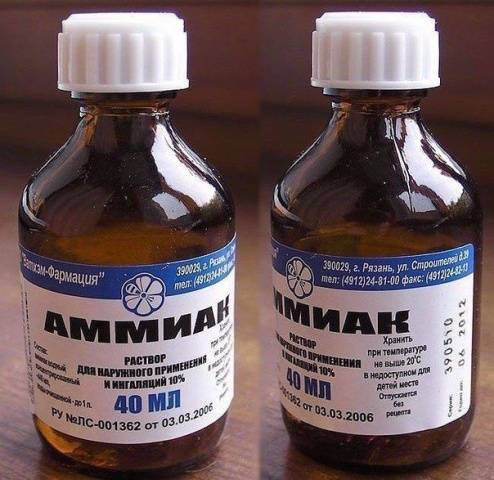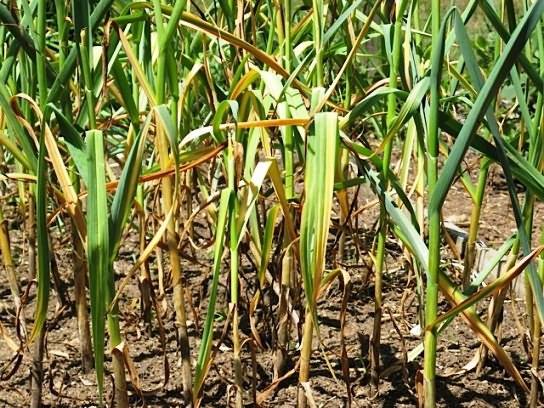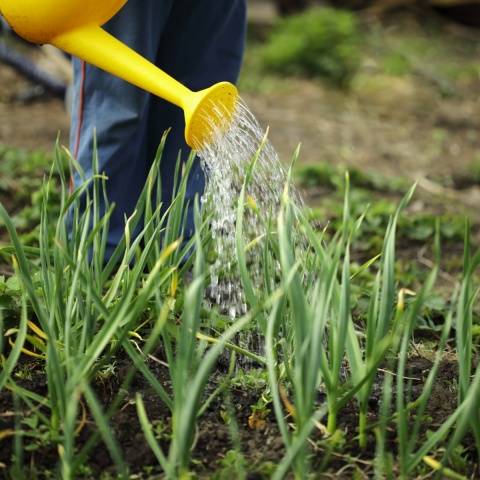Content
When growing garlic, gardeners are faced with various problems: either it does not grow, then for no reason the feathers begin to turn yellow. Pulling the garlic out of the ground, you can see small worms or rot on the bottom. How to deal with such problems, by what means to get rid of adversity.
Very often, vegetable growers do not want to resort to special fertilizers, they want to grow organic products. Experienced farmers have long been using funds from the pharmacy in their gardens. Feeding garlic with ammonia is one of the options for saving plants and the possibility of obtaining large heads with many cloves. The article will discuss the role of ammonia as a fertilizer and a lifesaver against pests.
What you need to know about ammonia
Ammonia is a gas that cannot be seen, but it can be easily identified by its smell. Ammonia, ammonia are the names of the same chemical that contain ammonia. Medicines are sold over the counter without a prescription. The main application is to bring a person to life when they faint.
Can you tell me what the garlic and the vegetable garden have to do with it? After all, plants do not need to be brought out of a swoon. Yes, it is, but plants need ammonia like air. Ammonia is an excellent nitrogen-containing fertilizer. The substance contains a large amount of nitrogen, it is necessary for the formation of chlorophyll in the green mass of plants. Despite the fact that this element is present in the air in large quantities, plants cannot assimilate it, they need nitrogen contained in the soil.
The role of nitrogen in plants
Nitrogen is called by agronomists bread for plants. When using nitrogen-containing fertilizers, nitrates accumulate in plants. With regards to dressings with ammonia, there are a lot of positive points:
- First of all, plants do not have ammonia depots, therefore, they cannot accumulate nitrogen obtained from ammonia.
- Secondly, the use of ammonia is much more economical. Fertilizers are very expensive today.
- Thirdly, the nitrogen obtained by plants during feeding activates the growth of the green mass of garlic, it becomes saturated, bright green.
- Fourth, there is no risk of overfeeding garlic with ammonia.
Do not wait until the feathers begin to fade and turn yellow, that is, signal that the garlic lacks nitrogen. Timely feeding of the plant will help avoid trouble. In addition, getting into the soil, ammonia improves the structure of the soil, normalizes its acidity.
Planting and leaving
Garlic, like any cultivated plant, needs feeding. In order for the plant to develop normally, you need to start feeding from the moment of planting. There are a number of fertilizers used to feed garlic during vegetative development. They should not be neglected.
After the bed has been prepared, it must be watered with a solution of ammonia to enrich the soil with easily assimilated nitrogen. To do this, prepare a composition of 10 liters of water and 50 ml of ammonia. The planted cloves will not only receive top dressing, but also protection from pests.
When the first two feather leaves appear, one more top dressing is carried out. Add two tablespoons of ammonia to a ten-liter bucket of cold water. This will be foliar feeding.
The following dressings can be carried out every 10 days with a less concentrated solution. Even if the plant doesn't give a signal, prevention never hurts. After watering and feeding, the soil in the garlic garden needs to be loosened.
When else does garlic need ammonia
How do you know that garlic needs to be fed with ammonia? The plant itself will "say" about it.
The tips of the feathers, regardless of the fact that the plants are constantly watered, turn yellow, the greens fade. This is the very first distress signal. The plant needs urgent help. You can provide it with the help of foliar dressing of garlic. For this, a solution is prepared in a ten-liter watering can with the addition of 60 ml of ammonia. It is advisable to spray garlic in the evening, after watering the ground with clean water.
Pests can cause yellowing of garlic feathers. So, ammonia not only makes up for the lack of nitrogen, but is also able to scare away harmful insects with its specific smell:
- onion fly and carrot fly. She lays eggs and garlic;
- aphids, capable of sucking juice from green mass;
- wireworm, eating up passages in the tender pulp of cloves;
- lurking proboscis or weevil, it can destroy the green feathers of garlic, eating passages in it.
Timely root and foliar feeding with ammonia will rid garlic of these pests. For this, a weak ammonia solution is prepared - 25 ml per 10 liters of water. So that the solution does not immediately drain to the ground, dissolve the laundry soap.
How to properly prepare a soapy solution:
- The soap is crushed with a grater and poured into hot water.
- When the soap solution has cooled slightly, it is gradually poured into water, with constant stirring. Stir until the gray flakes disappear. Rainbow bubbles should form on the surface of the water.
- After that, ammonia is poured in.
It is necessary to water and feed the garlic with ammonia at the same time once a week or every 10 days during the entire vegetative period. Only then can the harvest be saved.
Ammonium for garlic and onions:
Security measures
Ammonium alcohol does not accumulate in the heads of garlic, that is, the grown products are safe for humans. But when working with him, you need to be careful, follow safety rules.
Let's take a closer look at this issue:
- If the gardener has hypertension, then he is forbidden to work with ammonia. Acrid fumes can provoke a sharp increase.
- Nothing can be added to the ammonia solution.
- Root or foliar dressing of garlic with ammonia should be carried out in calm weather.
- If ammonia gets on the skin or eyes when preparing the solution, rinse quickly with plenty of clean water. If the burning sensation does not stop, you should seek the help of a doctor.
- When feeding garlic with ammonia, you must use gloves and a mask.
To store ammonia, you need to find a place where children and animals cannot reach. The fact is that a sharp inhalation of ammonia can cause a reflex cessation of breathing. If, through negligence, ammonia gets into the mouth, then it causes severe burns.
Let's summarize
So, the competent use of ammonia in a personal plot or dacha helps to solve a double problem: it is used as a universal fertilizer for obtaining a rich harvest, and protects plantings from harmful insects.
The reason for the love of gardeners for ammonia is the harmlessness to plants and humans. After all, nitrogen does not accumulate either in garlic, or in onions, or in other fruits after feeding with ammonia. The same cannot be said for many nitrogenous fertilizers.
Experienced vegetable growers can determine by the state of the plant whether the next garlic dressing is needed. Beginners do not always succeed. Overfeeding with nitrogen can cause stunted growth. Therefore, we advise you to feed the garlic no more than once every 10 days with a not too concentrated solution.














How is ammonia different from ammonium nitrate? we have always used ammonium nitrate .. and not only for garlic
Good afternoon, Nadezhda! Without going into the chemical constituent of each substance, the difference between ammonia and ammonium nitrate is as follows. Ammonium alcohol is an aqueous solution of ammonium hydroxide. Any aqueous solutions penetrate into the soil more easily, are absorbed faster by plants (after all, we are talking about the purpose in order to fertilize). That is why the article describes the use of ammonia for the purpose of fertilization and prophylaxis against insects.
Ammonium nitrate (ammonium nitrate) is a nitric acid salt - a chemical compound. Yes, it also contains ammonia and nitrogen, but ... Any chemical compound is absorbed by plants much longer. Moreover, it is still chemistry. Every gardener knows what nitrates are and how they can harm the body. It is ammonium nitrate with excessive feeding that can cause the accumulation of a large amount of nitrates in vegetables. Therefore, saltpeter must be used strictly in the indicated doses.